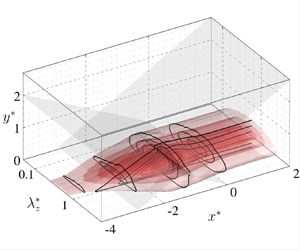Article contents
A spectral inspection for turbulence amplification in oblique shock wave/turbulent boundary layer interaction
Published online by Cambridge University Press: 28 October 2022
Abstract

Turbulence amplification and the large-scale coherent structures in shock wave/turbulent boundary layer interaction flows have been studied at length in previous research, while the direct association between these two flow features is still lacking. In the present study, the transport equation of turbulent kinetic energy spectra is derived and utilized to analyse the scale-by-scale energy budget across the interaction zone, enabling us to reveal the association between the genesis of the large-scale motions and the turbulence amplification. For the presently considered flow with incipient shock-induced separation, we identified in turbulent kinetic energy spectra distribution that the most energetic motions are converted from the near-wall small-scale motions to large-scale motions consisting of velocity streaks and cross-stream circulations as they go through the interaction zone. The amplification of streamwise velocity fluctuation is triggered first, resulting in the emergence of large-scale velocity streaks, which is attributed to the adverse pressure gradient, as indicated by the spectra of the production term. The energy carried by large-scale velocity streaks is transferred to other velocity components by the pressure-strain term, producing large-scale cross-stream circulations. When large-scale motions are convected downstream, their energy is transferred via turbulent cascade to smaller scales and dissipated by viscosity. The spanwise uniform fluctuations, reminiscent of the unsteadiness of the separation bubble, are contributed primarily by the inter-scale energy transfer from the finite spanwise scale motions.
- Type
- JFM Papers
- Information
- Copyright
- © The Author(s), 2022. Published by Cambridge University Press
References
- 10
- Cited by



